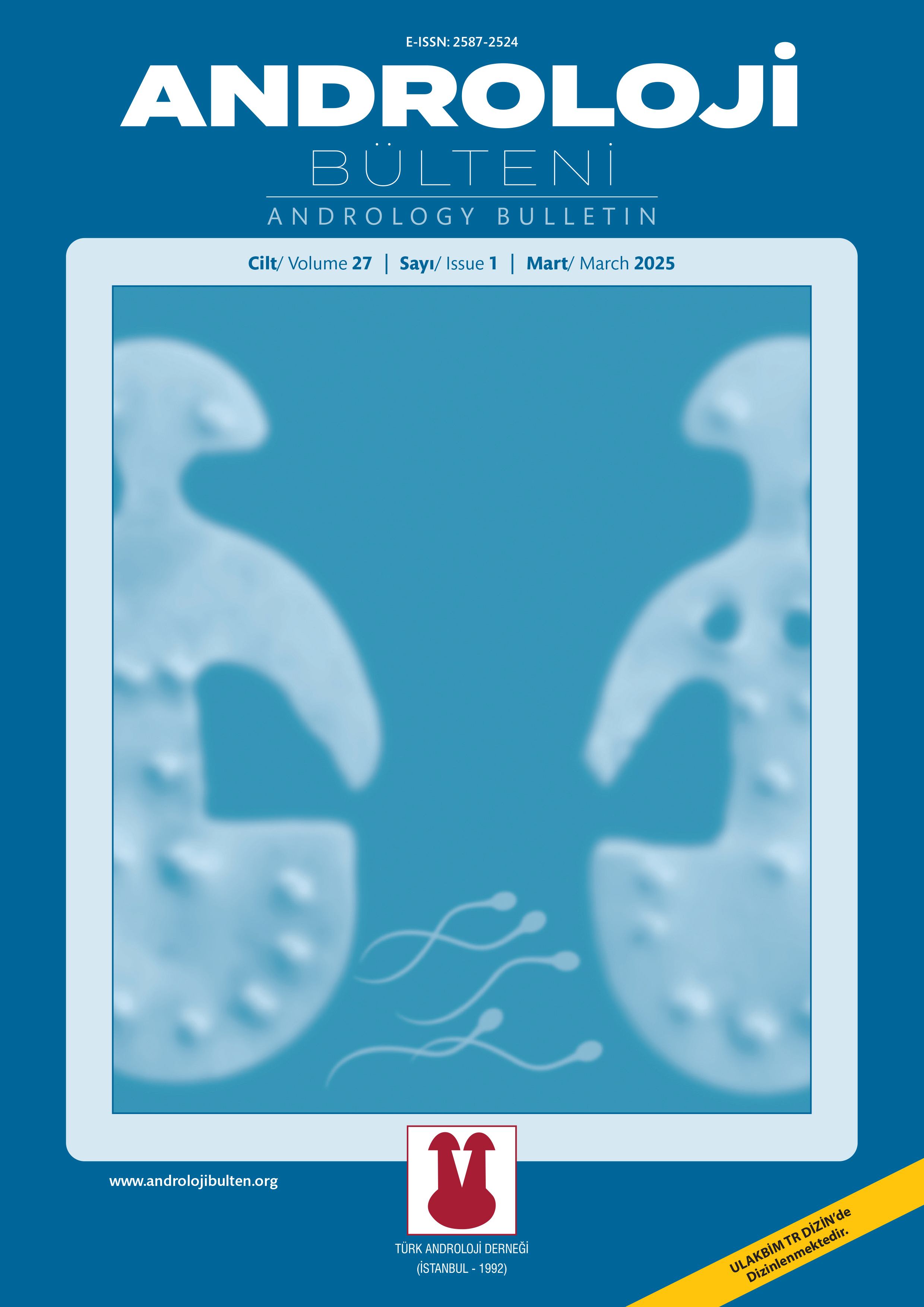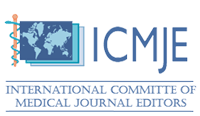INDEXES

Content of this journal is licensed under a Creative Commons Attribution-NonCommercial 4.0 International License.
Volume: 19 Issue: 4 - 2017
| 1. | Cover Page I |
| 2. | Editorial Board Page II |
| 3. | Reviewers Page III |
| MESSAGE FROM PRESIDENT | |
| 4. | From The President Page V |
| EDITOR'S CORNER | |
| 5. | From The Editor Page VI |
| INDEX | |
| 6. | Contents Page VII |
| CLINICAL ORIGINAL ARTICLE | |
| 7. | The comparison of the effect of Isoeugenol-based novel potent antioxidant and melatonin on testicular tissues in torsion induced rat model Fikret Erdemir, Esra Fındık, Mustafa Ceylan, Erkan Söğüt, Sevil Çaylı, Hakan Kesici doi: 10.24898/tandro.2017.54366 Pages 111 - 116 INTRODUCTION: Testicular torsion is an ischemic process. Although detorsion of testis is necessary for treatment, it has been shown that this approach may lead to oxidative damage via release of reactive oxygen species. Various antioxidant agents have been used previously to show their antioxidative effects on ischemia-reperfusion injury in many organ systems. In present study the effect of new antioxidant agent on testicular tissues was evaluated in testicular torsion induced rat model. METHODS: Thirty-two male Wistar albino rats, age 5.5 to 6 months and weighing 250 to 300 g, were used in this study. The rats were randomly divided into four groups. Group 1 (n=8) control group; the rats in this group were used to determine basal values for biochemical and tissue evaluation. In Group 2 (n=8), torsion and detorsion was created. Group 3 (n=8) received a 50 mg intraperitoneally melatonin to determine the effect of melatonin on serum and tissue oxidative stress parameters after testicular torsion/detorsion is created. Group 4 (n=8) received a 30 mg intraperitoneally new antioxidant agent to determine the effect of this agent on serum and tissue oxidative stress parameters after testicular torsion/detorsion is created. The tissue levels of oxidative stress parameters such as malondialdehyde (MDA), superoxide dismutase (SOD), glutation peroxidase (GSH) were studied in all groups. The serum levels of the same parameters were also studied in the blood (5 ml) which were drawn from the vena cava inferior of all the rats just before sacrification. RESULTS: The serum levels of MDA, SOD and GSH increased in the Group 2 in comparison to the control (P<0.05). Administration of melatonin caused a decrease in lipid peroxidation and antioxidant enzyme activities when compared to the torsion group (P<0.05). Administration of new antioxidant also decreased the levels of MDA, SOD and GSH in serum in comparison to Group 2. After treatment with melatonin and new antioxidant the testicular damage was diminished. Testicular germ cell apoptotic index was detected as 1.5%, 15%, 3.2% and 6% in Groups 1, 2, 3 and 4 respectively (p<0.05). There was no statistically significant difference between Group 3 and Group 4 in terms of serum antioxidant activity. DISCUSSION AND CONCLUSION: The results of this study showed that experimentally induced testicular torsion causes oxidative stress. The new antioxidant agent decreased the negative effect of oxidative stress in testicular torsion. This new antioxidant agent can be used alternatively to decrease the negative effects of testicular torsion. |
| 8. | The long term clinical results of penile prosthesis implantation in the treatment of erectile dysfunction Bilal Habeşi Gümüş, Ali Can Albaz doi: 10.24898/tandro.2017.54771 Pages 117 - 122 INTRODUCTION: The aim of this study is to evaluate the long-term clinical outcomes of penile prosthesis implantation in our clinic for the treatment of patients with organic erectile dysfunction (ED) METHODS: We retrospectively analyzed the data of 34 patients who agreed to participate in the study from 52 accessible patients who were diagnosed with organic ED in our clinic and who had undergone the penile prosthesis implantation for 60 months or more. Patient demographic data, the type of prostheses, peroperative and postoperative complications, postoperative couples’ satisfaction were evaluated. RESULTS: The mean age of the 34 patients with penile prosthesis implantation was 61.97±10.55 years and the mean body mass index was 27.55±4.33 kg/m2. 23 of the patients (69.6%) had a history of smoking. The malleable prosthesis was implanted to 15 patients (44.1%), the 2-piece penile prosthesis to 14 (41.1%) patients and the 3-piece prosthesis to the remaining 5 (14.7%) patients. Penile prosthesis was performed with cefazolin and gentamicin prophylaxis in 34 patients by penoscrotal incision. There were no peroperative complications in any patient. Penile tension/pain in one patient, localized infection in 2 patients with an on site antibiotherapy and re-implantation due to a mechanical problem in 1 patient. Penile prosthesis was removed due to prosthetic infection in two patients. The mean follow-up was 86.47±31.78 months and approximately 82.4% of patients and 70.5% of their partners were satisfied with the surgical results of the penile prosthesis operation. DISCUSSION AND CONCLUSION: Penile prosthesis implantation is an invasive and effective form of treatment as a third-line treatment in the treatment of erectile dysfunction. In this method of providing patient and co-satisfaction at high rates, infection is the most common serious complication, despite appropriate surgical procedures. |
| 9. | The impact of prostate calcification on lower urinary tract symptoms Eyüp Veli Küçük, Ahmet Tahra, Ahmet Bindayı, Ümit Yıldırım, Resul Sobay, Uğur Tolga Şen doi: 10.24898/tandro.2017.99266 Pages 123 - 126 INTRODUCTION: We aimed to evaluate the effect of prostate calcification on lower urinary tract symptoms (LUTS). METHODS: Patients who applied to urology clinic due to lower urinary system symptoms between 2010–2016 were retrospectively evaluated. A total of 177 patients were enrolled to this study; 58 patients without calcification, 63 patients with mild calcification and 56 patients with moderate/marked calcification. We classified the patients into three groups; those with no calculi, with mild calcification (<3 calcification, < 3 mm length) and with moderate/ marked calcification (≥3 calcification, ≥3 mm length). Patients filled the International Prostate Symptom Score (IPSS) and their maximum flow rates (Q max) were assessed. Categorical variables were evaluated with chi-square by variance analysis of continuous variables. Correlation evaluations were done by logistic regression analysis. RESULTS: The mean age was 56.5. Prostatic calcification was associated with age, but there was no positive correlation between prostate volume and PSA level, and no association with body mass index (BMI). Age adjusted analysis showed that; storage, voiding total IPSS were not correlated with calcification. As to IPSS, no relationship was found between maximum flow rate and prostatic calcification. DISCUSSION AND CONCLUSION: Prostatic calcification is not a determining factor in the assessment of LUTS severity. |
| REVIEW | |
| 10. | Testosterone replacement and Cardiovascular side effects Ali Atan, Süleyman Yeşil, Fazlı Polat doi: 10.24898/tandro.2017.28199 Pages 127 - 130 Testosterone (T) is a hormone produced by the connection between the hypothalamus, pituitary and testis. It is known that T has positive effects on many organs and systems. In spite of these beneficial effects, there are concerns about some adverse effects on the prostate and cardiovascular system. The association of T with prostate cancer has been intensively studied in recent years and it has been shown that endogenous T levels and T-replacement therapy have no effect on prostate cancer formation. In this review, we present the effects of T on the cardiovascular system by looking at the current international literature. |
| 11. | Delayed orgasm and anorgasmia Serdar Aykan, Serkan Gönültaş, Mehmet Yılmaz, Muhammet Murat Dinçer doi: 10.24898/tandro.2017.68552 Pages 131 - 137 Orgasm timing disorders are common but least studied and least understood of male sexual disorders. It covers a wide spectrum of diseases ranging from premature ejaculation to delayed orgasm/ anorgasmia. Delayed orgasm/anorgasmia is the state of disease leading anxiety caused by late orgasm even though there is adequate sexual stimulation. Delayed orgasm/anorgasmia disrupt sexual intercourse leading anxiety and sexual dissatisfaction as other male sexual disorders and furthermore it has negative impact on reproductive health for some patients. We evaluated pathophysiology with diagnostic and therapeutic features of delayed orgasm/anorgasmia in the light of current literature. |
| 12. | The rol of seminal fluid in fertilization Murat Serkant Ünal, Mehmet Caner Özer, Ferhan Hacioğlu Sönmez, Gülsen Bayrak, Hatice Oruç Demirbağ doi: 10.24898/tandro.2017.35403 Pages 138 - 143 The researches on male infertility in the past years were focused on sperm but in these days, the investigations gathered pace with understanding the seminal fluid. 90% of the seminal fluid consists of prostate and seminal vesicles secretions, and a small amount consists of bulbourethral glands (Cowper) and epididymis secretions. Seminal fluid has many functions. It includes fructose which is the main source of energy for spermatozoa, and protects spermatozoa against reactive oxygen species (ROS) by using antioxidant systems. After ejaculation, seminal plasma forms an isolation to antibacterial acidic field of vagina (pH 4–4.5), inhibits immune reaction and transports spermatozoa to the cervix. It contains factors that disrupt the capacitation of spermatozoa to prevent early activation and plays a role in the implantation of the fertilized ovum with progesterone. Also seminal fluid helps in sperm-oocyte interaction by preserving the molecular structure of the spermatozoa. Spermatozoa gain the ability to fertilize, which complete the capacitation and acrosome reaction, in the process of post-testicular maturation. Chemical signals, secreted by the oocyte and surrounding follicular cells, guide the capacitated sperm. Fertilization is a complex molecular event that begins with the connection between a sperm and an oocyte, and ends with the intermingling of maternal and paternal chromosomes. The good quality of the seminal plasma as well as the spermatozoa and oocyte may increase the success of spontaneous pregnancies and intrauterine insemination. In this review, it is to be discussed and searched answers for how the differences in semen viscosity and biochemical content affect fertilization and IUI success. |
| PUBLICATIONS AND CONGRESS CALENDAR OF ANDROLOGY | |
| 13. | Andrology Publıcatıons In Turkey Pages 146 - 150 Abstract | |













